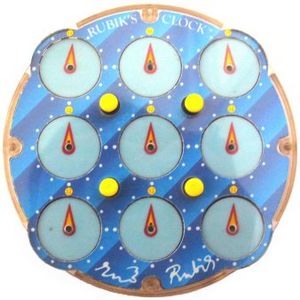Rubik's Clock facts for kids
The Rubik's Clock is a cool mechanical puzzle. It was invented by Christopher C. Wiggs and Christopher J. Taylor. Later, Ernő Rubik, a famous Hungarian inventor, bought the idea. He then sold the puzzle under his own name. It first came out in 1988.
This puzzle has two sides. Each side shows nine clocks. There are four wheels, one at each corner. You can turn these wheels to move the clocks. The corner clocks are special. They turn on both sides of the puzzle at the same time. This means there are 14 clocks you can control.
The puzzle also has four buttons. These buttons go through both sides. If a button is pushed "in" on one side, it's "out" on the other. The button's position changes how the clocks connect. This lets you turn different groups of clocks together using the wheels.
The main goal of the Rubik's Clock is to set all nine clocks to 12 o'clock. You need to do this on both sides at the same time. A common way to solve it is to first make a "cross" shape with the clocks set to 12. Then, you solve the corner clocks.
The Rubik's Clock is one of the 17 official events in the WCA. People compete to solve it as fast as possible. They also compete for the fastest average time over five solves.
Contents
How to Solve the Rubik's Clock
Solving the Rubik's Clock is a bit like solving a Rubik's Cube. You start by getting the middle and edge clocks right on one side. Then, you do the same for the other side. After that, you work on one corner at a time.
To solve a corner, you turn the clocks around it. You keep turning them until they match up. Then, you turn them all back to 12 o'clock. You repeat this for all four corners. Once all corners are done, your puzzle is solved! The Rubik's Clock is unique because the same solving method works for everyone, no matter how fast they are.
How Many Ways Can It Be Set?
There are 14 clocks you can move on the Rubik's Clock. Each clock can be set to 12 different positions. This means there are a huge number of possible ways the clocks can be set. In fact, there are over 1.2 quadrillion (1,283,918,464,548,864) combinations! This number does not even include the different ways the buttons can be set.
Who Holds the Records?
People around the world compete to solve the Rubik's Clock as fast as they can. Here are some of the top records.
The fastest time to solve a single Rubik's Clock is 3.29 seconds. This amazing record was set by Suen Ming Chi from Hong Kong. He achieved this on March 23, 2019, in China.
The record for the fastest average time over five solves is 3.86 seconds. This record belongs to Yunhao Lou from China. He set it on December 13, 2020, also in China. His times for that average were 3.52, 4.28, 4.57, 3.54, and 3.76 seconds. The fastest and slowest times are not counted in the average.
Top 5 Solvers by Single Solve
| Name | Fastest Solve | Competition |
|---|---|---|
| Suen Ming Chi (孫銘志) | 3.29s | GDSY Open 2019 |
| Dmitry Gundin | 3.34s | MPEI Open 2019 |
| Yunhao Lou (娄云皓) | 3.40s | Shenzhen Open 2018 |
| Evan Liu | 3.51s | George School Open 2019 |
| Tairan Zhong (钟泰然) | 3.64s | WCA Asian Championship 2018 |
Top 5 Solvers by Average of 5 Solves
| Name | Fastest Average | Competition |
|---|---|---|
| Yunhao Lou (娄云皓) | 3.86s | Guangzhou Good Afternoon 2020 |
| Tairan Zhong (钟泰然) | 4.53s | China Championship 2019 |
| Dmitry Gundin | 4.99s | MPEI Open 2019 |
| Suen Ming Chi (孫銘志) | 5.04s | GDSY Open 2019 |
| Wojciech Knott | 5.14s | Polish Championship 2018 |
See also
 In Spanish: Rubik's clock para niños
In Spanish: Rubik's clock para niños


